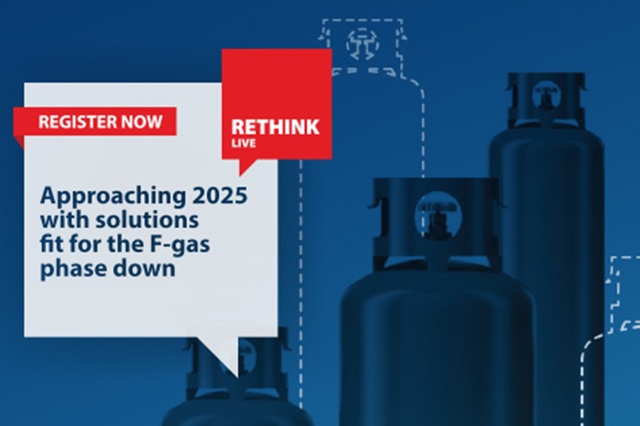Regulatory changes and the derived implications for the RACHP Industry are constantly increasing. The main driver for those changes are environmental concerns (health), resource efficiency and mitigation of climate change. The EU F-gas regulation is considered a front runner, preceding the Kigali Amendment to the Montreal Protocol and going beyond the latter.
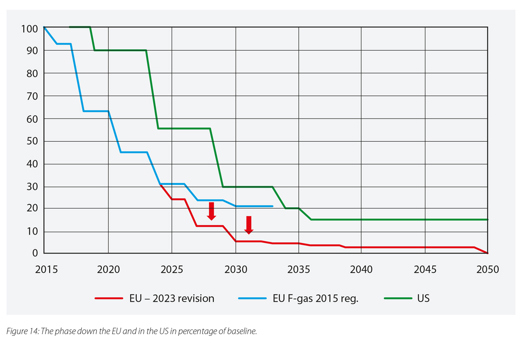
The review of the EU F-Gas regulation:
The EU F-gas regulation is considered a front runner, preceding the Kigali Amendment to the Montreal Protocol and going beyond the latter.
The first EU F-gas regulation came into force in 2006 with a focus on containment and service. In 2015 the second version came into force, introducing the phase down of high GWP hydrofluorocarbon (HFC) refrigerants. On February 20, 2024 the new EU F-gas regulation was published in the official Journal of the EU.
The latter is an extremely ambitious regulation with a long-term full phase out of F-gases. The EU and the US phase down are illustrated in Figure 1 where the 2015 F-gas regulation is shown in comparison with the new 2024 agreed phase down. From 2025 the quota is reduced significantly compared to the previous phase-down and from 2030 the available amount of F-gases even for service is challenged.
The quota allocation mechanism has in principle not changed but the previously exempted Metered Dose Inhalers (MDI’s) will be included in the quota as of 2025. Specific sub-quota allocations are made for MDI’s and the available amount for the RACHP industry is consequently reduced with a significant percentage which still has to be exactly specified. The allocation mechanism can be found in the Annex VIII of the Regulation.
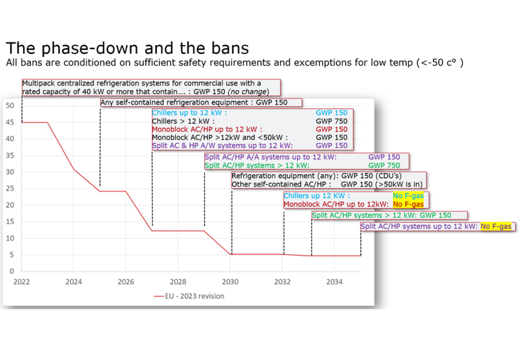
The EU equipment bans:
The quota reductions are accompanied by Placing on the market Prohibitions (Bans). Compared to the last revision the amount of bans and level of detail introduced is increasing.
Especially the bans outlined in figure 2 were a big discussion theme during the review period. In the light of the aggressive quota reductions the long-term consequence of having an application specific GWP ban is limited due to the pressure on availability of refrigerants via the phase-down steps (measured in CO₂-equivalents, i.e. GWP multiplied by metric quantity, resulting in highest pressure on higher GWP refrigerants) . However, it sends a clear signal to market on where to focus development efforts.
Export ban: From 2025 the F-gas regulation introduces an export ban for RACHP systems intended for the use of refrigerants with a GWP ≥ 1000 provided that these systems cannot be placed on the EU market.
This means that the date of the bans will set the date for the potential export limitations. The restriction is new and there have been discussion around it. The Commission has stated that application designed for multiple refrigerant use can apply the lowest GWP refrigerant as the measure for determining whether the product can be exported. The intention of the EU is to address concerns about dumping of equipment, which is obsolete in Europe, into developing countries’ markets.
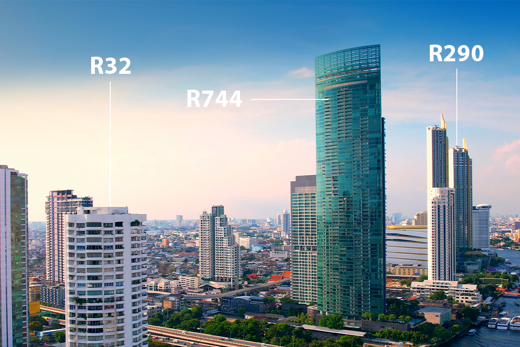
Heat Pumps:
The EU ambitions on decarbonizing the heating sector imply a massive rollout of heat pumps to phase-out fossil fuel-based heating. The market for heat pumps is already in acceleration mode and there have been valid concerns regarding the availability of F-gases, especially for some of the technologies. This has led to a yearly assessment and a possible extra - but very limited – quota for the years 2025-2029. The concern is particularly related to split systems <12 kW which will also be subject to a GWP limit of 150 from 2027. This can become a serious problem as raised by many industry associations. Small split systems have generally moved to the high pressure refrigerant R32 and a high pressure low GWP version is not available today.
Further, the level of flammability of A3 refrigerants such as hydrocarbons, leads to liability concerns of OEMs.
On the other hand, some important applications like small (<12 kW) A/W monoblock heat pumps will have GWP limits of 150 from 2027 and a full F-gas ban from 2032. However, many of those units are today already using R290 so it is not expected to become a major problem.
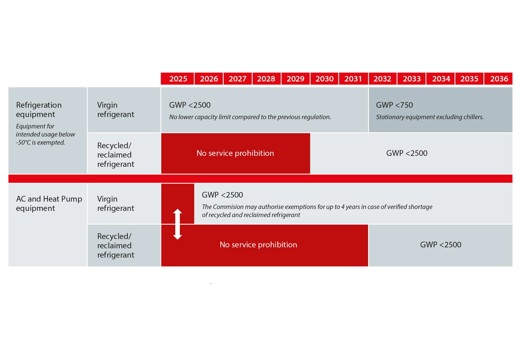
Service bans:
Service bans have been strengthened. As of 2025, also small refrigeration systems will no longer be allowed to use virgin refrigerant with a GWP >2500. This will target old systems still relying on R404A. From 2032 the limit will be further decreased to a GWP 750. Service and maintenance of AC and HP equipment will likewise be restricted to a GWP level of 2500 from 2026. It is important to notice that reclaimed and recycled refrigerant can still be used. An overview of the service ban can be seen in Figure 3.
Solutions, tools and expertise for F-gas compliance


FAQ's
More about refrigerants

Want to know more about refrigerants?
Danfoss is a world leader in the supply of compressors and controls, and has one of the most extensive and complete product ranges in the HVAC/R industry. Our products are found in numerous business areas and applications. We are at the forefront in developing products using refrigerants and in evaluating the viability of new refrigerants as they are introduced.





